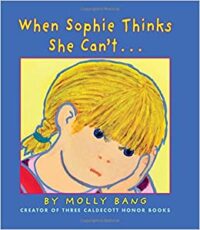SEL Read Aloud: When Sophie Thinks She Can’t… by Molly Bang

Summary
In “When Sophie Thinks She Can’t…” by Molly Bang, Sophie is a little girl who loves gardening. One day, when she is struggling to solve a jigsaw puzzle, her older sister walks up and solves it for her, telling her she wasn’t smart enough to solve it herself.
The next day at school, Sophie is still upset and convinced she isn’t smart. Her teacher, Ms. Mulry tells her class that the brain is a muscle they need to exercise and gives them a puzzle to solve: How many different kinds of rectangles can they build with 12 square tiles?
Even though Sophie knows she is good at gardening, she remembers how she couldn’t solve the jigsaw puzzle and doesn’t want to try. Her classmates, Paula and Andrew, encourage her, and Sophie notices them trying different strategies, so she decides to try drawing the squares.
All three struggle with their strategies, until Ms. Mulry introduces the word “yet” to the class and encourages them to keep trying. Sophie, Paula, and Andrew all change their strategies a little bit. Sophie makes a connection to one of her strengths and draws a garden. Eventually, all three make a rectangle, even though Sophie initially doubts because hers is different.
Ms. Mulry draws all the solutions on the board and tells the class that they have made their brains stronger by trying something hard.
When Sophie goes home, she sees her dad struggling to a fix cabinet door. She tells him about the word “yet” and offers to help, until they fix it together.
Comprehension Questions
Six questions aligned to Bloom’s taxonomy for teacher’s to evaluate students’ comprehension
- Remembering: Who helps Sophie feel better when she thinks she can’t do puzzles?
- Understanding: How does Miss Mulry explain the concept of becoming “smart” to her students?
- Applying: In what ways do Sophie and her classmates help each other during the math puzzle challenge?
- Analyzing: What role does the concept of “yet” play in changing Sophie’s mindset about her abilities?
- Evaluating: Judge whether Sophie’s approach to the puzzle can be applied to all challenges in life and why.
- Creating: Propose a new challenge for Sophie and her friends that would help them stretch their brains even further.
CASEL Discussion Questions
Five questions aligned to the CASEL competencies for teachers to foster an engaging discussion and foster social-emotional learning
- Self-Awareness: How did recognizing her feelings about puzzles help Sophie understand her own strengths and weaknesses?
- Self-Management: In what ways can setting personal goals, like deciding to tackle the math puzzle, help you grow and improve?
- Social Awareness: How do Sophie and her classmates show empathy and support for each other during the puzzle challenge?
- Relationship Skills: Discuss the impact of positive words and encouragement on relationships and personal growth, as seen between Sophie and her classmates.
- Responsible Decision Making: Discuss how thinking ahead and considering different outcomes can help when faced with a tough choice, similar to how Sophie approached solving the math puzzle.
Design Thinking Challenge
Take students’ learning even further by incorporating the Imagineerz design thinking framework
Create a “Can-Do” Puzzle for Sophie
Understand
- Begin by reading “When Sophie Thinks She Can’t…” by Molly Bang. Discuss the themes of the book, especially focusing on Sophie’s journey from doubt to confidence. Engage students in a conversation about challenges they face and how they feel when they think they can’t do something. Ask: Why do you think Sophie believed she couldn’t solve puzzles? Have you ever felt similarly about a challenge?
Ideate
- Encourage students to brainstorm ideas for a puzzle or game that could help someone like Sophie realize their potential and shift from “I can’t” to “I can”. Discuss what elements such a puzzle should include to be challenging yet achievable, fostering a sense of accomplishment and growth. What kind of feedback or design could the puzzle provide to encourage persistence and creative problem-solving?
Prototype
- In groups or individually, students will create a prototype of their “Can-Do” Puzzle using materials like cardboard, paper, strings, beads, and other recyclables found in the classroom. They should aim to make the puzzle engaging and adjustable in difficulty. Consider how the puzzle can visually represent progress and success to motivate users. Encourage them to be innovative in how the puzzle interacts with players, possibly including hints or steps to build confidence gradually.
Test
- Invite students to present their puzzles to the class, explaining the inspiration from the book, how the puzzle works, and how it aims to inspire confidence and a growth mindset in players. Allow classmates to attempt the puzzles, focusing on the experience of overcoming obstacles and reaching solutions.
- Gather feedback: Is the puzzle approachable yet challenging? Does it effectively communicate progress and encourage persistence?
Read Aloud
Additional Resources
- When Sophie Thinks She Can’t… on Amazon
- Math Activity from Development and Research in Early Mathematics Education (DREME) at Stanford University
- Picture-Based Discussion Questions from Scholastic
Copyright Notice
The image on this page comes from the book When Sophie Thinks She Can’t… by Molly Bang. Copyright © 2018 by Molly Bang.


